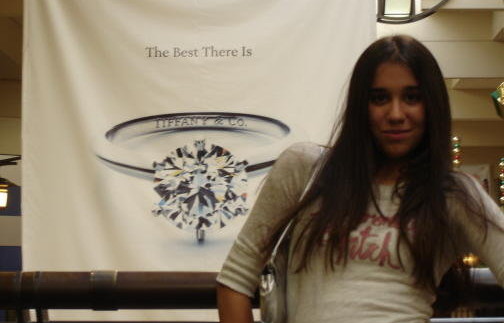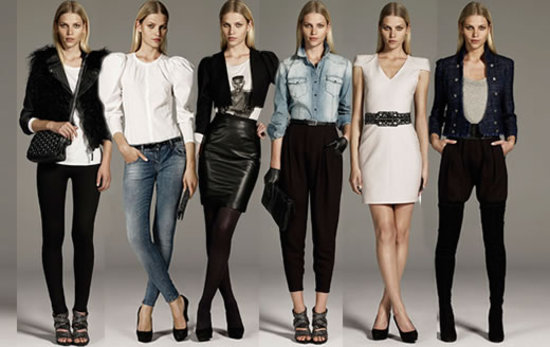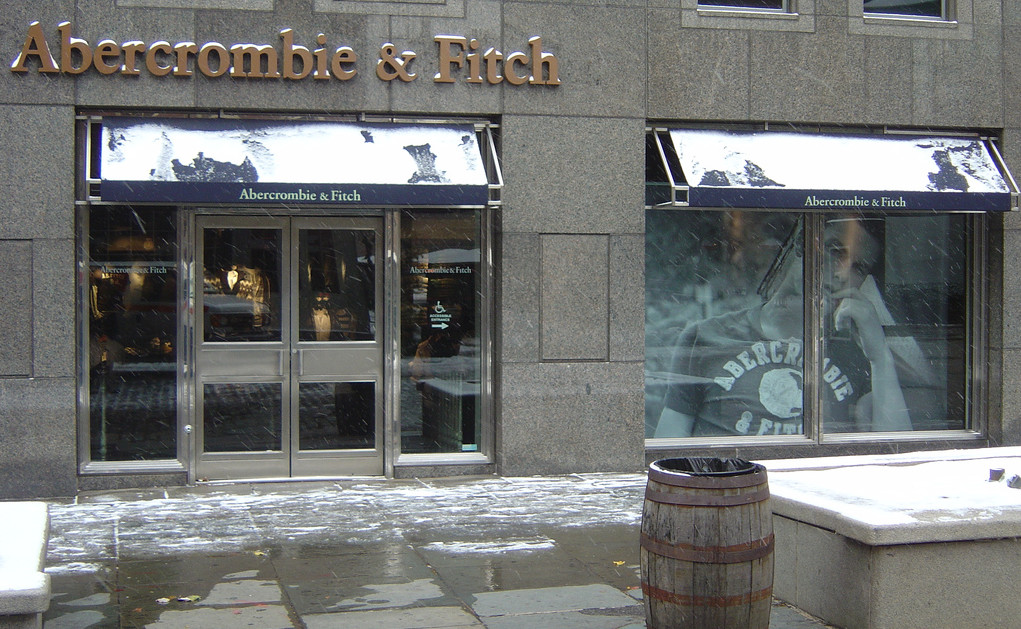“That’s why we hire good-looking people in our stores. Because good-looking people attract other good-looking people, and we want to market to cool, good-looking people. We don’t market to anyone other than that. In every school there are the cool and popular kids, and then there are the not-so-cool kids. Candidly, we go after the cool kids…A lot of people don’t belong, and they can’t belong. Are we exclusionary? Absolutely.” — Mike Jeffries, (former) CEO of Abercrombie & Fitch, 2006
My first ever item from Abercrombie & Fitch was a distressed denim miniskirt with a silk belt, in a bright green, blue, and white Pucci-inspired pattern, that I begged my mom to buy me. I was a chubby twelve-year-old who had just moved from a private elementary school with 15 kids in my class to a public middle school with over 400. I was lost, scared, and confused – not so much over who I wanted to be, but over who I thought I should be. The almost pitch-black store with the thumping trance music and suffocating cologne-smell seemed to offer the image I so desperately wanted: to belong.
I don’t think wearing Abercrombie ever made me any ‘cooler,’ but during those growing pains it did give me the relief of blending in. My clothes, adorned with little mooses and seagulls, looked like everybody else’s – and I was just fine with that, thank you very much. Having Abercrombie & Fitch, Hollister, and American Eagle inside your label was the norm in an era that encouraged kids to wear their brand loyalty, literally, on their sleeve (or feet, or purse, or…butt).
 An ironic comment on branding and capitalism? Nah, just a 2004 Myspace profile pic.
An ironic comment on branding and capitalism? Nah, just a 2004 Myspace profile pic.
But when Mike Jeffries stepped down last week as A&F’s CEO, a position he has held since 1992, I was just as unsurprised as the rest of the world. My indication of Abercrombie’s declining popularity among teens came long before the stocks started falling and when the brand was only on the cusp of what would be many racist/misogynistic/size-shaming controversies. Enter: my little sister.
I knew Abercrombie was in trouble way back in 2009 when I attempted to hand down my moose-ridden wardrobe to my sister, who was five years younger than me and now going through her own middle school experience. “What do you mean you don’t want anything?” I remember asking in disbelief when she refused to take any of my old clothes. “Everyone wore this kind of stuff when I was your age.”
“Nobody wears Abercrombie anymore,” the 13-year-old so wisely informed me. “I wouldn’t want to be seen with a moose on my shirt.”
So what happened? How did A&F go from Queen of the Quad to another piece of clothing in the donate-to-Goodwill pile?
FAST FASHION, INDIVIDUALITY, AND THE PLIGHT OF THE TRY-HARD
 A page from Zara’s lookbook in the 2009-2010 season.
A page from Zara’s lookbook in the 2009-2010 season.
“Today’s teens are no longer interested in ‘the elite, cool-kid thing’ to the extent that they once were, says [Erik] Gordon, the Michigan professor. ‘This generation is about inclusiveness and valuing diversity. It’s about not looking down on people.’”
The above quote is one of the answers New York Magazine poses in ‘Why Abercrombie is Losing its Shirt.’ But is it that kids are no longer interested in being ‘cool,’ or has the definition of what being cool is just changed?
As brands like Abercrombie, Hollister, and American Eagle continue to struggle, it’s worth looking at what’s doing well – specifically fast fashion stores like H&M, Forever 21, and Zara, who rip trends straight from the runways and create more affordable reproductions.
There is, of course, the obvious appeal that H&M and Forever 21 clothes tend to be cheaper than A&F (Zara’s teen section can range from cheaper to similar prices). But I don’t think that’s the bulk of their appeal. Wander around any of those three stores and there’s a huge range of styles – of metaphorical and literal hats you can wear – from maxi skirts and lace bralettes to professional blazers and slacks.
While Abercrombie kept trying to make everyone look the same, fast fashion’s open-door policy had something for everyone. You can now mix-and-match the pieces to create whoever you want to be and that’s just fine – as long as you don’t look like anyone else.
Although I agree with the Michigan professor’s belief that today’s “youth” are more inclusive and socially-aware than we were in the early aughts, I don’t believe that it has much influence on fashion. Instead, I think we’re living in an age where individuality is king. Cool clothes don’t come from the mall anymore. They’re the authentic French military bomber jacket from that Thrift Shop You Probably Haven’t Heard Of Yet or the kimono you found at the Salvation Army. If Regina George still rules the school, she’s doing so in the skirt that was her mom’s in the 80s (vintage! So adorable).
Moose emblems and Louis Vuitton monograms and Juicy Couture sweats – they are now the symbol of the try-hards, ironically because they represent that you just didn’t try hard enough.
Maybe we’re stuck in a limbo between ‘basic’ and ‘normcore,’ trying so hard to prove we aren’t trying at all. Or, maybe, there’s just something we care more about.
BECOMING EXPERIENCE-ALISTIC
“This saps money away from clothing in two ways. One, it gets teens spending on electronics, and two, they need wifi on which to operate their gadgets, as the Times wrote. Wander around a city and where does wifi exist? Restaurants. That may be one reason why spending on food has spiked — teens hang out at restaurants more in order to be able to use their new Androids.” — “The Cheapest Generation” via The Atlantic
Abercrombie has recently tried to make changes to appeal to their deserting clientele – stripping logos off shirts, inserting the once-banned color black into their lines, and providing plus-sizes. But the other side of trying to understand the brand’s (and plenty of other mall stores) downfall is figuring out what kids are spending their money on instead. And pretty much every journalistic outlet has come to the same conclusion: tech, tech, and more tech, as embodied by the Subaru publicist who told the Atlantic, “the Millennial wants to tell people not just ‘I’ve made it,’ but also ‘I’m a tech person.’”
I don’t buy this. I grew up in Silicon Valley and I don’t buy this. You can now take pictures, listen to music, and make phone calls all on the same device. Ten years ago I needed a digital camera, an iPod Mini, and a Motorola Razr to do all of the above. Having an iPhone or a Droid doesn’t say ‘I’ve made it’ or ‘I’m a tech person’ more than it says ‘I like having a phone that lets me check my Facebook and edit photos of me and my cat at the same time.’
This got me wondering, what do we spend our money on? And, of course, the answer was right there on my phone – specifically, within my Instagram app.
Music concerts. Brunch. Trips traveling the world. Vegas. Brunch. Front row at a Giants game. Visiting friends across the state. Festivals. More Brunch.
None of the snaps were of clothes, or purses, or shoes – they were of experiences. Memories and moments and trying new things. Evidence of a generation that has swiftly transitioned from the materialistic to the experience-alistic. Not so much spending more money on food because restaurants provide free wifi, but because everyone can’t stop instagramming pictures from that restaurant with the hashbrowns as big as your face.
I’m not jaded. I refuse to believe that someone would go halfway around the world to take a photo of Sydney at sunset, or shell-out $500 for an audience shot while on a guy’s shoulders at Coachella, for the Insta hearts and follows. Instead I think social media is constantly exposing us to new experiences – places we’ve yet to see, clubs where we’ve yet to dance, and foodie-approved dishes we’ve yet to eat – making us realize all the things we’ve yet to do.
The teenagers of today have realized that looking like everyone else doesn’t get the likes. But maybe the twentysomethings have finally realized that a paycheck spent on labels doesn’t add much to life.


loved this! i was just reminiscing about abercrombie and fitch the other day, the brand I once begged my mother to dress me in, and this article hit so many points on the head! thanks for the good read anneta!